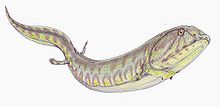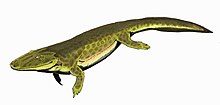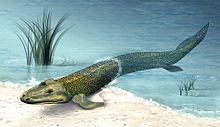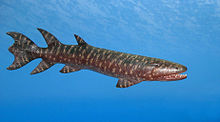Tetrapod
In biological systematics, vertebrates with four limbs (extremities) are referred to as terrestrial vertebrates or tetrapods (ancient Greek τέτρα tetra, German 'four' and πόδ- pod-, German 'foot'). These quadrupeds include the amphibians (Amphibia), the sauropsids (Sauropsida) - including the reptiles in the classical sense (Reptilia, paraphyletic) and the birds (Aves) - and the mammals (Mammalia) including humans. Today, about 35,000 animal species belong to the tetrapods.
In the course of evolution, some groups of terrestrial vertebrates have also conquered water and air space as habitats. Due to the adaptation to these habitats as well as to special ways of life, the designation "quadruped" is not always to be taken strictly literally. In snakes, for example, all four legs have been secondarily lost again. In birds and bats (and also in the extinct pterosaurs) the forelegs have each evolved into differently constructed wings. While the amphibians, as the most "primitive" tetrapods, live as larvae in the water and only go ashore as adults, some representatives of the "higher" terrestrial vertebrates (amniotes) have returned to life in the water, either partially (seals, penguins) or completely (whales, manatees, some sea snakes). In seals, the feet have been transformed into flippers, as have the two front feet in whales and manatees - the rear ones have been regressed.
Features
A number of adaptations are necessary for life on land. The paired fins of the fish, pectoral and pelvic, become arms (front legs) with hands (front feet) or legs (hind legs) with feet (hind feet). The basic structure of the inner skeleton of these limbs, consisting of upper arm/leg, lower arm/leg, and hand/foot, is already given by their descent from certain fish-like flesh-finned animals (cf. Rhipidistia). Elbow/knee joints, hand/foot joints, and movable fingers/toes are new. A "primitive" feature of recent land vertebrates is considered to be a finger/toe number of five. However, early land vertebrates had more than five fingers/toes; Acanthostega had eight fingers, Ichthyostega had seven toes, and Tulerpeton had six fingers. In some groups of recent land vertebrates, e.g., certain caudates, birds, cloven-hoofed and uncloven-hoofed animals, the number of fingers/toes was further reduced either as locomotion became more specialized or as limbs generally regressed.
Since the body experiences significantly less buoyancy outside of the water, the skeleton must support the weight of the body and compensate for compression and extension stresses that are transferred from the limbs to the trunk through standing and walking. To stabilize the trunk, therefore, the vertebrae often have enlarged contact surfaces and shortened but strong spinous processes as the attachment for powerful back muscles. This, together with the limb girdles and extremities, results in a suspension bridge-like construction. The pelvis is firmly attached to the spine via the sacrum, the shoulder girdle is only connected to the spine via muscles and ligaments.
Nearly all adult terrestrial vertebrates take in oxygen from the air with the help of lungs, including † ichthyosaurs, whales, and manatees, which have secondarily returned to obligate aquatic life.
Body parts and organs that are only useful for a permanent life in water are deformed: unpaired fins, gills, branchiostegal apparatus and gill cover (operculum) as well as lateral line organ. An exception regarding the presence of (however free, unprotected) gills and a lateral line organ are the primarily aquatic larvae of amphibians. Only some aquatic amphibians, such as the clawed frog or the axolotl, retain their lateral line organ or even breathe through gills throughout their life. Due to the reduction of the gill cover, the shoulder girdle is no longer firmly attached to the skull. As a result, all terrestrial vertebrates have a more or less pronounced neck.
Land vertebrates have a middle ear for the perception of airborne sound. It corresponds to the spiracular pouch of fish-like flesh fins and is sealed off from the outside by a tympanic membrane. The vibrations of the eardrum, which is set in vibration by sound waves, are transmitted to the inner ear by a bony rod, the columella. The columella corresponds to the hyomandibulare of fish-like flesh fins, a relatively large bone by which the jaw apparatus (including the palate) was movably suspended from the skull in the region of the temporomandibular joint. The change in function of the hyomandibulare was made possible by the more or less rigid connection between the maxillary palatal complex and the cranium in terrestrial vertebrates, which in turn was made possible by the reduction of the gill apparatus. Mammals possess, in addition to the columella (stapes), two other ossicles that arose from bones of the lower jaw: Malleus and Incus.
History of Development
It used to be assumed that the ancestors of the land vertebrates today preserved as fossils were coelacanths, which in the Upper Devonian crawled out of the water onto the shore on four stalked, muscular, tassel-like fins to move short distances on land. At that time, the waters had dried up with increasing frequency, and the fish had been compelled to move to land to conquer new habitats. The legs of amphibians evolved from the fins used on these land journeys in the course of macroevolution.
According to recent findings, the first animals systematically counted among the terrestrial vertebrates, whose descendants finally conquered the land 365 million years ago, still lived in the water - their legs thus developed there. The actual ancestors of this group of animals were then relatives of the lungfish, which moved with four limbs, already similar to legs, on the marshy ground of freshwaters overgrown with water plants. For example, the fish-like Panderichthys, which is about 365 million years old, has bones that reveal its close relationship to terrestrial vertebrates. Acanthostega also proves that the four limbs of land vertebrates already evolved in water. Its forelimbs and hind limbs are built in such a way that the bones could not have supported the heavy body on land. In addition, Acanthostega still breathed through gills and not lungs, so it was clearly an aquatic animal that moved with four legs in the water.
See also: Shore leave (biology)

Diadectes

Alpine Salamander

Crassygyrinus scoticus

Tulerpeton

Ichthyostega

Tiktaalik

Panderichthys

Eusthenopteron
Questions and Answers
Q: What are tetrapods?
A: Tetrapods are four-legged land animals that are vertebrates.
Q: What is the name of the locomotion used by tetrapods?
A: The kind of locomotion used by tetrapods is called quadrupedal.
Q: Which groups of animals are tetrapods?
A: Amphibians, reptiles, dinosaurs (including their direct descendants, the birds), and mammals are all tetrapods.
Q: Why are snakes considered tetrapods even though they don’t have limbs?
A: Snakes evolved from animals that had four limbs, so they are still considered tetrapods.
Q: From which group of fish did the earliest tetrapods evolve?
A: The earliest tetrapods evolved from the Sarcopterygii (lobe-finned fish).
Q: When did the transition from fish to air-breathing amphibians occur?
A: The transition from fish to air-breathing amphibians is believed to have occurred in the Upper Devonian period.
Q: What is mosaic evolution?
A: Mosaic evolution is the process by which transitional fossils gradually acquire characteristics of their descendants over time. In the case of tetrapods, the transition from fish to land-dwelling animals was marked by the acquisition of new characteristics that allowed them to survive in a different environment.
Search within the encyclopedia